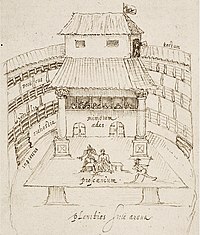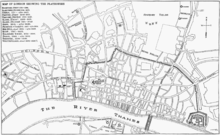The Swan (theater)
| The Swan | |

|
|
| location | |
| Address: | Paris Garden (now overbuilt) |
| City: | London (Southwark) |
| Coordinates: | 51 ° 30 '28 " N , 0 ° 6' 10" W |
| Architecture and history | |
| Construction time: | 1594-1595 |
| Opened: | 1595 |
| Spectator: | 3,000 seats |
| Hardly used after 1615; passed after 1632 | |
The Swan (German: Der Schwan) was a theater built in 1595 in Southwark , London , England . It was the fifth in a series of newly built theaters in London. After James Burbage's The Theater (1576), the Curtain Theater (1577), the Newington Butts Theater (1575–1577) and Philip Henslowes Rose (1587–1588). The Swan was located near a manor in the Liberty of Paris Garden (no longer existing as a separate district ), on the Bankside district of Southwark , near today's Blackfriars Railway Bridge and opposite the City of London , 120 m from the Thames bank .
prehistory
Francis Langley , a London fabric checker and loan shark who lived from 1548 to 1602, was a busy entrepreneur. William Ingram, Langley's biographer, explains that in 1589 Langley acquired the derelict Paris Garden mansion and property for £ 850 from its former and indebted owner, Thomas Cure , a saddler on the farm. The property, once part of the possessions of the Templar monastery of Bermondsey , came into royal and private ownership after the dissolution of the English monasteries . It was below the high water level and the manor house was in a corresponding state. This was u. a. From 1603 (until 1631) used as a brothel under the name Holland's Leaguer , named after the operator Elizabeth Bess Holland, which is still remembered today by a street name (not to be confused with the mistress of the same name of Thomas Howard, 3rd Duke of Norfolk , who died in 1547 ) . By 1595, Langley had built 13 houses, nine of which were rented. After 1595 he built more units on the manor's property.
The theater
Ingram suspects that Langley watched the Rose Theater, which reopened after a previous wave of plagues in London died down in June 1594, and how numerous visitors to the Rose landed at the Paris Garden Stairs and refreshments at the nearby Falcon Inn (or Falcon Tavern, one of William Shakespeare's hangouts and its actors) before walking past his property to the theater. So he decided to build a competing theater. He was also able to use the somewhat unsightly, swampy corner of the property, on which an old mill pond was previously located, for economic use. According to Ingram, it was estimated to cost £ 1,000 to build. Ingram concludes from a protest note written in November 1594 by the Lord Mayor of London to William Cecil, 1st Baron Burghley , Advisor to Queen Elizabeth and Lord High Treasurer , that the foundation stone for the Swan Theater was laid that year. Assuming this, it was probably completed in 1595. However, it is unclear whether the Swan was used for theater plays as early as 1595. It is certain that there was a theater company in 1596 that played in the Swan. Incidentally, the mayor's protest was fruitless, as the property was previously owned by the Crown and he had no authority outside the City of London.
Johannes De Witt , a Dutchman who visited London around 1596, left a description of the theater in his, now lost, manuscript "Observationes Londiniensis": Translated from Latin it says that the Swan is "the finest and largest London amphitheater " , with a capacity of 3,000 spectators. Built on flint -cement ( "flint concrete") and its wooden columns were painted so skilfully that "they could make the most attentive observers believe that this marble was" and so the Swan gave a "Romanesque" appearance. De Witt also drew the exterior of the theater. The original is lost, but a copy made by Arendt van Buchell has been preserved; the only contemporary drawing of an Elizabethan theater that still exists today. It is often claimed that the drawing depicts the Lord Chamberlain's Men who appeared there in the summer of 1596. However, this is not considered certain. Theater-goers could reach the theater by water and land at the Paris Garden Stairs or the Falcon Stairs .
The theater business
In 1597 the Swan Theater was played by the Pembroke's Men . New cast members were Richard Jones, Thomas Downtown and their director Edward Alleyn after losing their positions with the Lord Admiral's Men at the competing theater, The Rose . In August 1597 there was a scandal when the Pembroke's Men brought the play The Isle of Dogs , written by Thomas Nashe and Ben Jonson , to the stage. In this now-lost satire , high-ranking political figures were mocked, including - depending on the source - Henry Brooke, 11th Baron Cobham or even the Queen. Jonson was arrested, along with two other actors in the performance, but released on October 3, 1597. Langley, already at odds with the Privy Council over non-theater related matters, exacerbated the dispute by allowing the theater company to re-stage the play - after the royal one Order to stop all theater performances and even to demolish the theaters. Perhaps this directive only affected Langley alone, the other theater companies, such as the Lord Chamberlain's Men and the Admiral's Men, who were licensed to do so in October, were allowed to return to the stage. However, the Swan continued to perform even without this permission. At this point, some of the players who were previously with the Swan have switched to the Rose. However, since the Pembroke's Men had a contract with Langley that forbade them to play anywhere other than Swan, the departed actors were sued by Langley in turn. The actors pointed out in their defense that the Swan lacks a required theater license. From February 19, 1598 the authorities became aware of this fact and the Swan was only used sporadically. Another scandal rocked the London theater world in 1602 when a Richard Vennar announced a new play called "England's Joy" to be performed at Swan on November 6th. Vennar advertised it as a "fantastic story in honor of Queen Elizabeth". The performance was sold out pretty soon, but the piece never got performed. The citizens were very upset and vandalized the theater. There was not only material damage, but also one in the public perception from which the Swan never really recovered.
The end
Because both the court and the city were keen to limit the number of acting companies in London, and because there were now many large open-air venues in the city, the swan had a limited time. Along with the controversial The Isle of Dogs , the most famous play that premiered here was "A Chaste Maid in Cheapside" by Thomas Middleton , performed in 1613 by the reunited Lady Elizabeth's Men . The theater also shows other popular entertainment, such as fencing (" swashbuckling competitions") and bloody animal spectacles ( bearbaiting ). After 1615, the Swan was unused for five years, but was replayed for a short time by some unknown actors in 1621.
When Philipp Henslowe built his Hope Theater in 1613 , as evidenced by the architectural drawings that have been preserved, he oriented himself more towards the Swan than his existing Rose Theater from 1587, which appeared out of date compared to the Swan.
Over the next two decades the swan deteriorated. In the pamphlet “ Holland's Leaguer ” published in 1632 , a satire that dealt with the use of the mansion in Paris Garden as a brothel, which ended only a year ago, the theater was described as “now in ruins” and “it hangs like a dying swan the head and sings his own funeral song ”In subsequent historical records, the Swan Theater no longer appears.
Web links
- The public theaters ("Public Theater") Information from the New Shake-speare Society (German)
Individual evidence
- ^ FE Halliday : A Shakespeare Companion 1564-1964 , Penguin, Baltimore 1964, p. 481.
- ^ A b c d Joseph Q. Adams: Shakespearean Playhouses: A History of English Theaters from the Beginnings to the Restoration , Cornell University 1917, pp. 160-180
- ^ A b William Ingram: A London Life in the Brazen Age , Harvard University Press , Cambridge 1978.
- ↑ Trussler, Simon. The Cambridge Illustrated History of British Theater . New York: Press Syndicate of the U. of Cambridge, 1994; P. 164 ff.
- ^ David Mateer: Edward Alleyn, Richard Perkins and the Rivalry between the Swan and the Rose Playhouses . Review of English Studies: The Leading Journal of English Literature and the English Language, Issue 60 (2009): MLA International Bibliography. Web. March 5, 2010.
- ^ A b Peter Thomson: The Cambridge History of British Theaters Ed. Jane Milling. Volume 1. Cambridge University, 2004; Pages 70-92.
- ^ Edmund Kerchever Chambers : The Elizabethan Stage, 4 volumes, Oxford, Clarendon Press, 1923; Volume 2, pages 411-414, read online
- ^ George Pierce: The Development of Shakespeare as a Dramatist , Macmillan Publishers , New York 1907; P. 50 n.2.


